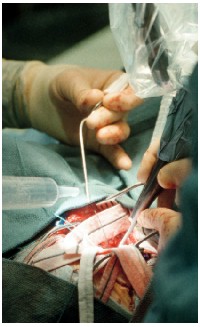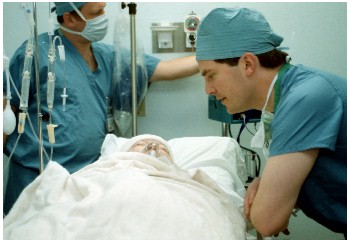
Vanderbilt surgeons use the free-electron laser to help remove a tumor from the brain of patient Virginia Whitaker. (photo by Dana Johnson)
Free electron laser shines in first surgical test

Dr. Michael Copeland talks with patient Virginia Whitaker after the procedure. (photo by Dana Johnson)
In a neurosurgical first, surgeons at Vanderbilt University Medical Center used a powerful laser originally developed for the "Star Wars" missile defense program to help remove a golf ball-sized tumor from the surface of a patient's brain.
The successful procedure, performed on a 78-year-old Kansas City, Mo., woman, marked the first-ever use of a free-electron laser (FEL) in a clinical operation.
Vanderbilt University's W.M. Keck Foundation Free Electron Laser Center is one of only five FEL centers in the country, and is the only facility that is equipped to perform human operations.
Dr. Michael Copeland, a former VUMC neurosurgeon now practicing in Kansas City, Mo., led the procedure to remove a three centimeter-wide benign mass from Virginia Whitaker's right temporal lobe.
Copeland and the surgical team, which included VUMC's Dr. Peter E. Konrad, assistant professor of Neurological Surgery, and Dr. Kevin P. Clarkson, assistant professor of Anesthesiology, used the FEL to cut out a sugar-cube-sized piece of the tumor before removing the remaining portion using conventional neurosurgical methods.
"Our goal for these initial surgeries using the FEL is primarily to prove that it is a safe device," Copeland said.
He participated in earlier studies which suggested that a particular wavelength of laser light generated by the FEL causes little collateral damage to tissues surrounding the target site. It's that potential for collateral damage that has until now limited the use of lasers in brain surgery.
Though it was originally developed by the U.S. Department of Defense as part of the Strategic Defense Initiative, the FEL is capable of generating laser beams of incredible delicacy.
Being the first person to ever undergo such a procedure didn't frighten Whitaker, whose five children all traveled to Nashville to be with her.
As a matter of fact, she welcomed the chance to be a part of making medical history.
"I think it's a wonderful opportunity to help other people in my situation as well as to help the doctors learn more. That's why I did it.," Whitaker said.
"For me, this had to be done no matter what, so it's good that maybe it can help other people too."
Whitaker began experiencing seizures associated with her tumor a year ago. Though they were controlled with medication, it became apparent that the tumor was getting larger.
When she came to him in November, Copeland realized that Whitaker might be a candidate for the FEL surgery.
"To participate in this surgical research study, the patient must have a tumor on the outside surface of the brain, so that we can cut into it without cutting through normal tissue," said Copeland.
"Mrs. Whitaker is very healthy and her tumor was located in an easily accessible site and was of a size that was still easy to resect.
"All the factors were favorable at this time."













